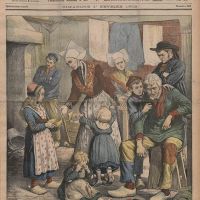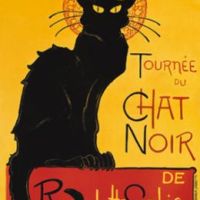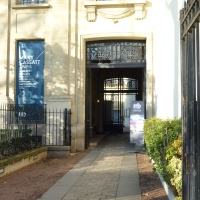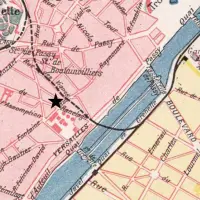Amid the oceans of heart-breaking news that surrounded us in March 2022, there was some good news from a French village called, appropriately, Island, in the department of the Yonne in Burgundy–Franche-Comté.

About 180 people live in the village, which is roughly halfway between Avallon to the east, where there is a railway station and a market, and Vézelay to the west, the walled hill town and pilgrimage site.

The village church is called St-Bénigne (in English, Saint Benignus), after a third-century missionary and martyr believed to be buried in Dijon (the cathedral there is also named for him). The first church on the site was built in the 12th century; the structure was rebuilt at least in part in the 16th century. It’s a lovely place on a hill outside the village, surrounded by a small graveyard, but it is no longer in regular use as a church. Once a year, in the summer, it is opened for a mass, and many local families attend this special event.

Our friends Patrice and Noëlle were among them in July 2017. Patrice used to be a restoration architect and Noëlle is a retired museum curator who trained at the school of the Louvre. They live nearby and were understandably curious to see the interior of the church.
There was a high altar of elaborately carved wood into which oil paintings of Christ and three saints were inset.

In front of the traditional high altar is a freestanding modern altar made of massive pieces of wood, sculpted from an oak that once stood in the park of the nearby castle.

In the following photograph, taken from between the high altar and the freestanding altar, you can just make out two large paintings on either side of the nave beyond the archway.

One is a depiction of the martyrdom of St-Bénigne, the other of the Assumption of the Virgin Mary. (According to tradition, the Virgin Mary was taken up – “assumed” – into heaven when she died, rather than being buried on earth.)
It is a lovely image. Mary is plump, with the pleasant round face of a farm wife. Around her, cherubs tumble in the clouds like children playing in the waves at the beach. But the painting is in very poor condition. You can see the holes in the canvas and the mouldy varnish at the bottom.

The painting dates from the 17th century, from the reign of Louis XIV. It was his father Louis XIII (1601–1643) who established August 15 as the feast day of the Assumption of Mary, to be celebrated with processions and prayers for the birth of a male heir to the king. And indeed, in 1638, after 23 years of marriage, Louis and his wife, Anne of Austria, had the child who grew up to be the Sun King. (The Val de Grace in Paris was Anne’s thank-you gift for this longed-for child.)
Patrice and Noëlle have suggested that the painting may date from 1646, the time of the first Vicar General of Island, a prominent cleric called Charles Trinquart d’Etampes. He had been an adviser to Louis XIII and supported the royal couple’s devotion to Mary and the celebration of the Assumption. He may have commissioned a local painter who used local models for the image.
Patrice and Noëlle went back the following year for the annual mass and Patrice spoke to Paule Buffy, the mayor of Island, about the need to restore the damaged paintings. In conversations with friends, Patrice and Noëlle formed the beginnings of a plan. A knowledgeable colleague estimated that each of the big paintings would take about 20,000 euros to restore properly. Fundraising efforts would need to draw in people far beyond the 180 residents of the village. To allow for donations, Patrice established an association called Vivre Island and began to sell memberships in the association to start raising money.
Later that year, Patrice also talked with representatives of a foundation called “Sauvegarde de l’Art Français,” which supports the restoration of art throughout France, including rural areas.
In August 2019, Patrice and Noëlle launched the first of a series of fundraising concerts, with a performance by two members of the baroque ensemble La Voilotte. They sold 86 tickets at 10 euros each. The mayor was astonished to see village residents she had not previously met, coming to enjoy the concert and support the cause.

The pandemic put a dent in the plans, but throughout 2020, the association continued to sell memberships and managed an outdoor cinema presentation in the summer that raised money. Events in the church restarted in summer 2021, with readings and further concerts. By the end of the year, the association had collected about 6,000 euros.
Then, in January 2022, Sauvegarde de l’Art Français informed the association that there was to be a competition for funding, sponsored by the insurer Allianz. In each region of France, three artworks would be nominated, each in need of restoration.* The winner would be chosen by email voting. The prize for the winner with the most votes in each region would be 8,000 euros.
In Burgundy–Franche-Comté, the three works were (1) a badly damaged statue of Bérénice in the museum of Baron Martin in Gray, a town of about 5,400 people 50 km east of Dijon; (2) a reliquary in Saint-Firmin, a village with 840 inhabitants about 100 km southeast of Island; and (3) the painting at Island. Here are the images from the contest website.
Voting took place between February 10 and March 10, 2022. All that was required to vote was a valid email address, and we immediately voted when Patrice and Noëlle told us about it. Patrice and Noëlle sent messages to all their friends and acquaintances and distributed flyers in Avallon.
From the outset, the competition was between Bérénice and the Assumption. Poor St-Firmin barely got a look in. At first, Island gained the greatest number of votes and it held onto the lead for most of the month. But on the very last day of the competition, we got an email from Patrice, sent to a long list of friends and supporters: “Aïe, on perd !” (Help, we’re losing!) The vote would close at midnight in France and Island was about 30 votes behind. It was then mid afternoon in France. But it was morning in Toronto.
Like everyone else on that list, we imagine, Norman and I mobilized to get out the vote. We wrote to family in Canada, in England, in the United States, in Austria. We wrote to friends near and far. A French friend in the history department at the University of Toronto promised to alert her colleagues.
Presumably, the folks in Gray were doing something similar, using their Facebook page and other networks. As the votes for the Assumption inched up, so did the votes for Bérénice. But as afternoon turned to evening in France, and morning turned to afternoon in Toronto, suddenly Island began to regain the lead. As I discovered when I pressed “Refresh” a couple of times on the website, new votes were being registered almost every minute. Of the 3,332 votes that Island earned to win the competition, almost a third came in that last day.
Norman and I celebrated in the evening and raised a toast to the Assumption of the Virgin and her unknown leagues of supporters. It felt like the only good news we’d had in weeks. In the space of a month, the association had more than doubled its funds and moved closer to the amount needed for restoration. The campaign to save Mary is far from over, but it has advanced considerably.
For more information, contact VIVRE ISLAND, 12 rue de l’Église, 89200 Island, France, or vivre.island@gmail.com
Text by Philippa Campsie with information provided by Noëlle and Patrice Roy, maps from Gallica, photographs by Patrice Roy.
*Of the three artworks nominated in the Ile de France, the Paris entry was the Plancher de Jeannot, which we wrote about here. It did not win.























I’m so glad she won the extra funding. A painting is going to deteriorate much more quickly than a statue.
Very true. Berenice is lovely, but she can wait a bit longer.
Merci beaucoup ! Je diffuse P
>
Merci a vous!
The funerary chapel at the end of my street in a village in the south Touraine has had money from Sauvegarde de l’Art francais, to save the badly damaged danse macabre wall painting (very rare as it has both male and female characters). They are the obvious organisation to go to for this sort of thing as the art they are primarily (maybe solely) interested in is religious art. They provide thousands of euros worth of grants every year. If my memory serves me correctly, they were originally set up and funded by a group of wealthy American women with connections to France in the first half of the 20C.
Congratulations to your friends on a successful campaign. I feel quite sorry for St Firmin.
Thank you for the background. Let’s hope St-Firmin gets a chance later on.
Thanks for this post Philippa. It’s an interesting story, and, as one of the Canadian voters, I’m glad to hear that I helped Mary win!
So glad that this beautiful painting is on the way to restoration.
Let me know how I can make a contribution.
I’ve always loved the fact that the church recognized the role of Mary in our salvation with this honour and special feast day.
Olive
Thank you so much. I will find out from Patrice how you can contribute. That is very kind of you.
SUCH a happy ending – good news indeed! Xo N.
>